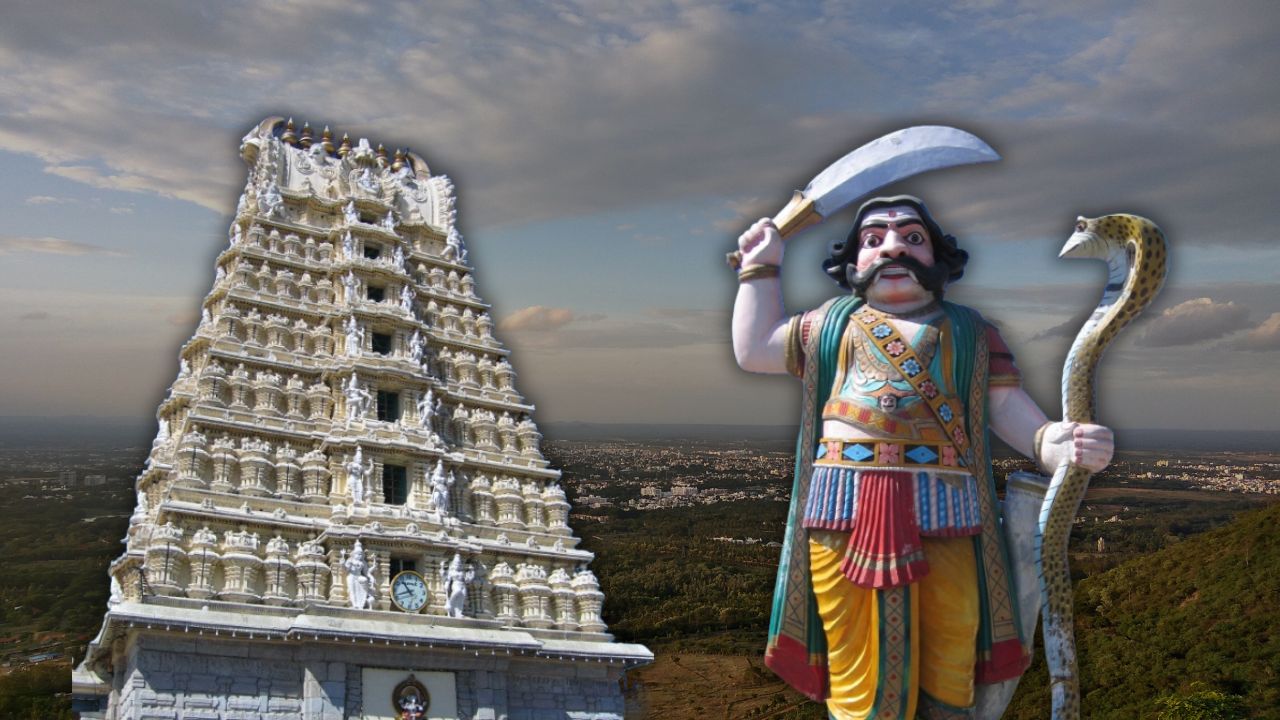The ban, which does not apply to residents of Chamundi Hills, prevents groups from celebrating the festival at the statue of Mahishasura. Organisers of Mahisha Dasara say it denies them the right to celebrate their cultural and historical legacy.
Published Sep 25, 2025 | 7:00 AM ⚊ Updated Sep 25, 2025 | 7:00 AM

With the hilltop venue out of bounds, the Mahisha Mandalotsava Samiti and supporters of the festival held their celebrations at the Town Hall.
Synopsis: The decision by the Mysuru Police to impose prohibitory orders for 200 metres around the iconic Mahishasura statue atop Chamundi Hills has drawn criticism from groups wishing to celebrate Mahisha Dasara, regarded as an alternative to the ongoing state-sponsored version of the festival. With hilltop celebrations blocked, the festival was held at Mysuru Town Hall, where supporters criticised the lack of state support and vowed to launch a movement to secure greater recognition.
Mysuru police have imposed prohibitory orders around the statue of Mahishasura atop Chamundi Hills, citing law-and-order concerns during the ongoing state-sponsored Dasara festival.
The move has drawn criticism from organisers of Mahisha Dasara, who say it discriminates against non-mainstream celebrations of the festival.
In an order issued on Monday, 23 September, Commissioner of Police Seema Latkar imposed had issued orders imposing prohibitory orders under section 163 of the BNS, 2023 around the statue, effective from 12 am on 24 September until 6 am on 25 September.
The official explanation cited differing opinions among various organisations regarding the Mahisha Dasara celebrations, and said the restriction was necessary in the interest of public safety and law and order, as thousands of devotees from across the country and abroad visit Chamundi Hills during Dasara.
The ban, which does not apply to residents of Chamundi Hills, prevents groups from celebrating the festival at the statue of Mahishasura. Organisers of Mahisha Dasara say it denies them the right to celebrate their cultural and historical legacy.
With the hilltop venue out of bounds, the Mahisha Mandalotsava Samiti and supporters of the festival held their celebrations at the Town Hall in Mysuru on Wednesday.
During the event, the committee passed three resolutions, including a call to rename Mysuru as “Mahisuru” in memory of Mahisha, described by them as a “benevolent Buddhist ruler.”
“Mahisha Dasara is not something that we started celebrating recently, it has been observed since time immemorial by our ancestors, who honoured Mahisha, however, it was never widely publicised,” former Mysuru Mayor Purushotham, part of the organising committee, told South First.
“When we say ‘Dasara,’ people immediately think only of Goddess Chamundeshwari. But along with her, we must also celebrate Mahisha Dasara.”
He stressed that their festival was not in opposition to the Chamundeshwari tradition and criticised the lack of state support for Mahisha Dasara. “All political parties have consistently ignored Mahisha Dasara. In the coming days, an intense movement will be launched regarding this issue,” he said.
Prominent personalities including Jnanaprakasha Swamiji, historian PV Nanjaraja Urs, and writer Prof KS Bhagwan attended the event. They demanded that Mahishasura be accorded equal respect alongside Chamundeshwari. Some warned that the matter may be taken to court if rights to celebrate were continually denied.
The controversy stems from contesting interpretations of Dasara and Mahishasura’s legacy.
Hindu tradition venerates Goddess Chamundeshwari as “Mahishasuramardini,” the slayer of Mahishasura, a demon, and a popular legend attributes Mysuru’s name to this story. The Chamundeshwari Temple on the hill, with its statue of Mahishasura, is central to the state-sponsored Dasara.
Called nada habba (state festival), it has been continuously celebrated by the Wadiyar kings of Mysuru, who ruled over the region first as vassals to the Vijayanagar kings, later as independent rulers, and finally under British suzerainty, from at least the 14th century. The present form is seen as a continuation of customs inherited from the Vijayanagar empire.
But groups like the Mahisha Mandalotsava Samiti argue that Mahishasura was not a demon, but an indigenous Buddhist ruler whose memory was maligned. Some tribal communities across India similarly mourn his death during Durga Puja, calling it the unjust killing of their ancestor. They also counter that the city’s name was derived from Mahisha, not from Goddess Chamundi’s epithet.
“The stories found in [Hindu] mythology have been written with deliberate falsehoods. The idea of ‘Mahishamardini’ (slayer of Mahisha) itself is a fabricated tale,” Purushotham asserted. “No matter what anyone says, we will not stop our celebration. We don’t need anyone’s permission to continue.”
Prof KS Bhagwan further linked the issue to social justice.
“Ninety seven percent of us, including Lingayats, Kurubas, Vokkaligas and those who don’t wear the linga, are still slaves. The BJP government is out to impose the Manusmriti as law. The Manusmriti shows Shudras in poor light, so what happens to the condition of women,” he said.
Similarly, Jnanaprakasha Swamiji questioned the state’s allocation of funds.
“The Dasara celebration is being organised with taxpayers’ money. When they went to Chamundi Hills to inaugurate the Dasara, they could have showered some flowers on the Mahishasura statue. Not even a seminar is being organised on Mahishasura,” he said.
“The government is spending ₹46 crore for Dasara, and if they give us just ₹1 crore, we will organise Mahisha Dasara. Equal respect should be given to Goddess Chamundeshwari and Mahishasura.”
(Edited by Dese Gowda)
